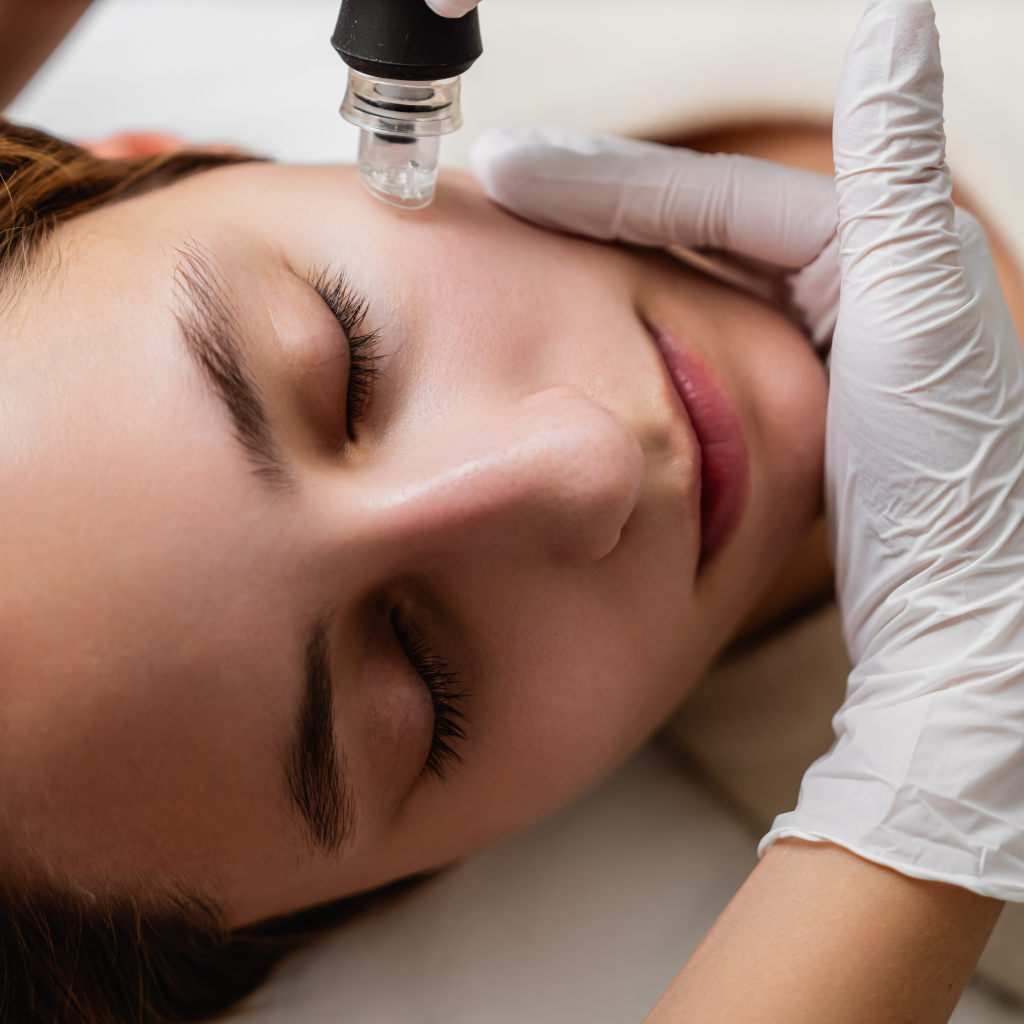Is HydraFacial Good for Skin? Benefits, Treatment Steps & Costs
- Home
- skin-rejuvenation
- is hydrafacial good for skin

A HydraFacial involves a gentle device that exfoliates and infuses nourishing serums all at once. This hydradermabrasion (a cousin of microdermabrasion) uses vortex suction to remove debris while delivering custom boosters. Many people appreciate its quick results, with little to no redness afterwards. Lots of folks ask, “Is HydraFacial good for skin?” It generally helps with dullness, uneven texture, and clogged pores. Sessions typically feel comfortable and are non‑invasive, making them appealing compared with harsher chemical peels or other resurfacing treatments.
HydraFacial Treatment Essentials
This popular approach can be the answer if you’re curious about what a HydraFacial treatment is. It’s a soothing method that targets multiple concerns, including dryness, discolouration and even fine lines. People often ask what the benefits of Hydrafacial are, as it cleanses and hydrates in one go. The patented machine combines three steps: cleansing, exfoliating and hydrating, which many compare to a mild microdermabrasion paired with a serum infusion. Because the process is customisable, your provider may include antioxidant or peptide‑rich serums aimed at brightening, calming or clarifying the complexion.
Exploring HydraFacial’s Steps
A HydraFacial usually starts with a gentle wash of your face to remove any surface buildup. Then, a spiral tip applies light suction while delivering active ingredients. If you’re wondering how to do a hydrafacial, it’s done by a trained technician who ensures each pass on the skin is even. Dead cells peel away, revealing a fresher look. The device also infuses specialised serums filled with peptides and antioxidants to nurture deeper layers. Throughout the session, the skin often feels cooled and pampered. Each step aims to brighten and soften the complexion without leaving it irritated or overly sensitive. This balance appeals to many who desire a straightforward yet effective facial procedure.
How Long Does a HydraFacial Last
The immediate radiance can persist for about five to seven days, but effects may continue if treatments are ongoing. Many people enjoy a lasting glow by spacing sessions every month or so. The goal is to keep pores clear and skin plump rather than waiting until issues arise again. Some find their complexion keeps improving with each procedure. Others notice a gradual reduction in rough areas or hyperpigmentation with repeated visits. Though outcomes vary, consistency typically brings the best benefits. You might even find that your skincare products at home work better after a session, further extending your healthy look. Regularity is key.

Deep Cleansing and Mild Chemical Peels
Deep cleansing removes stubborn dirt that rests under the surface. Many procedures skip thorough pore care, but this one excels with gentle extraction. The bonus of mild chemical peels helps whisk away dead layers, revealing fresher cells. Results can appear smooth and more refined right after the session. These peels often use low concentrations of acids to dissolve tired, topmost cells, similar to what’s seen in hydradermabrasion studies. By addressing clogged pores and brightening at the same time, HydraFacial offers a two‑in‑one approach.
Why Deep Cleansing Matters
Impurities collecting in pores can make skin look dull or textured. By clearing away buildup, you let healthier cells shine through. With HydraFacial’s focused suction, oil and trapped debris come out of congested areas more easily than potentially risky, forceful extractions. Plus, unlike some rough treatments, it’s designed for comfort. This kinder approach suits many skin types, including folks who worry about scarring or redness from manual extractions. Reducing blocked pores can also minimise blemishes down the road. When breathing room is given to your skin, it can reflect light better, making it look livelier. For many, that’s the key to a revived appearance.
Pairing Chemical Peels with HydraFacial
Some HydraFacial protocols include gentle chemical peels to enhance exfoliation. These formulas often use low concentrations of acids to dissolve tired, topmost cells. Such light peels bring out a smoother layer without the severe flaking linked to stronger peels. By adding chemical exfoliation, you address clogged pores at a deeper level and balance your skin’s tone. People might see fewer fine lines or fewer dark spots after several sessions. Each peel can be tailored so your provider chooses solutions best for your concerns. It’s all about a guided synergy: peel away what’s dull, then infuse what’s nurturing. Together, they can help you hit reset on your complexion with fewer irritations.
Focus on Fine Lines and Wrinkles
Early lines can show up when the skin loses moisture and elasticity. A HydraFacial supports renewal by gently clearing dead skin cells and introducing hydrating ingredients. Many want a smooth appearance, which is why reducing fine lines and wrinkles is a popular reason to explore this treatment. The exfoliation step boosts cell turnover, while infusion of growth factors and peptides can encourage collagen production, making it a non‑surgical option for anti-ageing.
Boosting Collagen for Smooth Skin
Collagen acts like the skin’s support beam. As people age, collagen naturally starts to dip, and combined with everyday stress, lines may become more noticeable. With consistent facials, especially ones designed to hydrate and brighten, you can help refresh the outer layer. Some HydraFacial solutions feature peptides or growth factors that nudge collagen production from beneath the surface. Over time, a gradual plumping effect helps fill in subtle creases. This approach is less abrasive than many invasive procedures. It’s all about coaxing your body’s systems to do some heavy lifting. Regular sessions, along with good lifestyle habits, might give you a smoother look and bounce.
Is HydraFacial Good for Oily Skin and Sensitive Skin
Figuring out if HydraFacial is suitable for oily skin or if it is good for sensitive skin comes down to balance. Oily complexions often crave deeper pore care without harsh stripping. Sensitive skin needs treatments that won’t set off redness. HydraFacial can be adjusted to suit both. The extraction step refines pores in oil‑prone zones. Meanwhile, the infused serums leave skin calm and hydrated. Even those who tend to redden easily often find the spiral suction less irritating than typical manual extractions. Of course, everyone’s skin is different. A quick patch test or talking with a specialist helps you decide the best path. Most see that the gentle approach rarely triggers harsh reactions, making it a versatile option.

Hyaluronic Acid for Dry Skin
Hydration is what parched skin craves most. That’s why hyaluronic acid gets plenty of praise in modern skin routines. HydraFacial steps often highlight moisture‑rich solutions that lock water in, targeting dryness at a deeper level. This ensures a luminous finish without leaving skin greasy or tight.
Locking In Moisture
Dry patches can become rough and flaky if left alone. Hyaluronic acid can bind water to the skin, so it remains supple. During a HydraFacial, specialised vials may drench your face in soothing fluids. This helps break the cycle of dryness before it worsens. Proper hydration can also reduce the appearance of fine lines since plumper skin often hides them more effectively. If dryness is chronic, repeated facials may gradually improve the overall texture. Think of it like watering a plant: you need to keep a consistent schedule to notice real growth. Once skin cells are happy, that radiance tends to stay longer between sessions.
Getting That HydraFacial Glow
Many seekers of a healthy complexion talk about the HydraFacial for radiant skin. This phrase captures the fresh, plump, and lightly dewy finish that can appear right after the session. It’s more than simple shine—there’s usually a newfound clarity and softness. Because dead skin cells have been removed and nourishing substances have been infused, the top layer reflects light more evenly. Events, gatherings or photo sessions are perfect times to show off this look. The glow also signals that the skin’s barrier is supported. Rather than a short‑term trick, it’s a sign that the cells are working well together, thanks to the synergy of exfoliation and hydration. And if you care for your skin at home, that brightness can last longer.
How Many Treatments in HydraFacial & Cost
Plenty wonder how many treatments they’ll need for the best results. Another big question is how much a hydrafacial costs per session. Both vary, but specialists often recommend monthly visits for maintenance. With new issues or bigger goals, more frequent appointments might help ensure progress.
Figuring Out How Many Sessions
A single HydraFacial can offer a nice boost, especially before a wedding, party or significant event. But for deeper concerns like stubborn, congested pores, a series might be better. Often, providers suggest at least three or four sessions spread out by a few weeks. This allows each treatment to build upon the last. If you’re battling chronic dryness, repeated infusions of hyaluronic acid can gradually rebuild moisture reserves. If you’re chasing brighter tones or fewer breakouts, routine visits keep skin balanced and clear. There’s no one‑size‑fits‑all rule, though. Some folks find that monthly tune‑ups maintain their glow long term. Others feel good with seasonal sessions. It’s about tuning in to your skin’s condition and deciding if you’d like consistent improvements.
Is HydraFacial Worth It
People weigh the price to see if it’s worthwhile. Is Hydrafacial worth it? A HydraFacial cost can change from city to city or depend on the clinic’s expertise. In many regions, the average price is around ₹12,000 to ₹18,000 per session, though packages or membership discounts can lower the per‑treatment cost. Some places bundle extra perks, like LED light therapy, which may bring added value. If you appreciate professional‑level cleansing, or you find that store‑bought products can’t solve your most challenging problems, a professional facial might be a wise investment. Many see it as a reliable way to keep complexions stable and resilient. The gentle nature also makes it less risky than more invasive procedures. With fewer side effects, you typically bounce back fast. Consider what you spend on scrubs, peels or lotions that don’t work, and compare that to a well‑planned facial. If your skin responds well and you skip potential missteps, you might conclude it’s a smart route.
Conclusion
A HydraFacial can refresh your face with minimal stress, targeting dead skin buildup and dryness. People of many ages turn to this procedure for help with lines, clogged pores, hyperpigmentation and large pores. If you’re after that brighter, plumper complexion and wondering, “Is Hydrafacial good for skin?”—the answer is that it can be, especially when tailored to your needs. This non‑invasive hydradermabrasion combines exfoliation, extraction and infusion in one session, leaving most complexions calm and glowing. Consistent sessions and good at‑home care could be a true game‑changer for oily, sensitive or dry skin alike.

Highly skilled cosmetologist at Tune Clinical Aesthetics, specializing in advanced skin and hair treatments.





